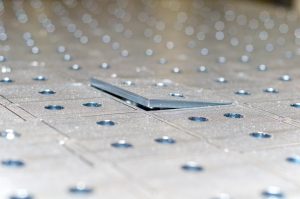
Shearing is a metal fabrication process that’s used to trim and remove unwanted material from sheet metal. It involves the use of a machine or tool, such as a bench shear, to slice through sheet metal with extreme precision. Shearing doesn’t require the use of heat — sheet metal is typically sheared while cold or at room temperature — nor does it produce waste in the form of chips, making it an attractive choice for manufacturers. To learn more about the metal fabrication process shearing and how it’s performed, keep reading.
How Shearing Is Performed
Shearing is performed by slicing through sheet metal with a blade-affixed machine or tool. Sheet metal is first secured between the tool’s or machine’s blades. Most shearing tools and machines have a squaring arm to control the location of the cut. After placing the sheet metal in the proper position with the squaring arm, the top blade drops to slice through the sheet metal. As the top blade comes down, the bottom of the sheet metal is pressed into a lower blade.
There are several types of shearing tools and machines, one of the most common being a bench shear. Also known as a lever shear, a bench shear is a cutting tool that’s mounted to a working surface, such as a workbench. It’s small, lightweight and easy to use, though it requires the use of a stable and secure surface for mounting.
Guillotine machines are also used to perform shearing. Also known as a power shear, it’s a more complex shearing machine that’s powered either mechanically or hydraulically. The powered blade allows guillotine machines to slice through sheet metal faster and more effectively than a bench shear.
Shearing Advantages
- Incredibly fast, with shearing cutting through sheet metal in just seconds
- Creates clean cuts with smooth edges
- Can be performed on sheet metal in a variety of diameter sizes
- Cost-effective for high-volume manufacturing applications
- Doesn’t produce waste in the form of chips
- Can be performed on room-temperature sheet metal, eliminating the need for heating sheet metal
- Numerous types of metals support shearing, including aluminum, steel, stainless steel, bronze, iron and copper
Shearing Disadvantages
- Not ideal for low-volume manufacturing applications
- Exceptionally hard metals like tungsten cannot be sheared
- May cause deformity in sheet metal
Shearing vs Die Cutting: What’s the Difference?
Shearing and die cutting are similar metal fabrication processes that involve cutting metal with one or more blades. The two metal fabrication processes, however, use different types of cutting blades. In shearing, straight blades are used. In die cutting, curved blades are used.
